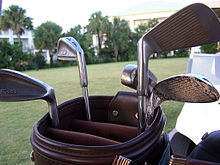By Alan Prescott
May 17, 2021

In my last article, I mentioned that there was one man, Karsten Soleheim, who, perhaps, had the most profound effect on the development of golf clubs, as compared to any other individual. Today’s discussion is dedicated to that man, who changed the playability of modern golf clubs even as they continue to evolve. Karsten was the father of the “perimeter-weighted golf club.
It all began when Karsten Solheim was an engineer, working for the General Electric Corporation in Binghamton, New York. In his spare time, he worked in his home garage, developing more forgiving golf clubs. At first, he worked on putters, those clubs used on golf greens to put the golf ball into the hole (or cup). After sometime, Karsten took his putters to the golf shops in Manhattan, one of the five boroughs in New York City. His putters were innovative. In fact you might say that they were ahead of their time. Many of the golf shops accepted his new putters on consignment. One year later, when Karsten returned to those same golf shops to see how his putters had sold, he found that most or all of them were still unsold. When he asked for feedback from the golf shop owners, he was told that their customers felt that his new putters were too light in weight.
At that point, Karsten reclaimed his unsold putters, telling the shop owners that he would be back with new, heavier and more useable models. Within a year later, Karsten delivered on his promise with his new, heavier putters. A short time later, he returned a third time to those golf shops and noticed that the new putters were sold out. His brilliance in manufacturing and development was also demonstrated by his honesty, integrity, and his strong desire to improve golf equipment.
Karsten’s genius in golf club manufacturing came to light with his theory of “perimeter-weighted” golf clubs. Up to the time that Karsten developed his new theory of perimeter-weighting, golf clubheads were center-weighted, meaning that most of the weight was concentrated in the center of the clubhead. Any shot, where the ball struck the clubhead even a fraction of an inch off-center, was penalized. Karsten found that, by distributing the weight of the golf club, off-center hits were NOT penalized so severely. Even his original putter, the Ping 1-A, had this perimeter-weighting feature. It also had a tuning fork sound, which gave further product identity, and led to the marketing of Karsten’s new golf club models, the Golf Industry’s newest and, perhaps, the greatest golf club innovation in the last 45-plus years.
However, as I mentioned in my prior article about Karsten Soleheim, his marketing approach actually made it difficult for “non-open air facilities” to setup accounts with his Company and brought attention back to on-course and golf range PGA Golf Professionals due to Karsten’s Golf Club Fitting System. The “PING Golf Club Fitting Chart” was a color-coded system that provided a method with which the PGA Golf Professionals could “customize” golf clubs to fit most golfers. The results were phenomenal for players. It was Karsten’s new system that changed the playability of golf clubs and made the game of golf easier for the average golfer. The expression that “you can buy a better game” was, in fact, somewhat truthful. Perimeter-weighted golf clubs were easier to hit.
Another factor or advantage was the fact that perimeter-weighted golf clubs were slightly longer and the heads had less loft (or “stronger”), thus allowing the golfer to hit each iron in a set further than the old styles of golf clubs. Furthermore, Ping golf clubs had that advantage of the new technology of perimeter-weighting, which made them easier to hit.
The year was 1977. Perimeter-weighted golf clubs were a new and exciting feature in the manufacture of golf clubs. Golf club prices were increasing. The public began to search for a way to lower the cost of the new technology of perimeter-weighting. Both the game of golf and the process of manufacturing golf were about to change again. The explosion of golf’s popularity seemingly had no limits. In my next article, I will look at how and why this happened. John’s journey continues as he approaches his graduation from the “School of the Business of Golf”. Please follow this journey, as it has affected most of today’s golfers.
I am Alan Prescott and I can be contacted at [email protected] for your comments and suggestions.
Please stay safe and remain healthy.
Editor’s Note: Alan Prescott reached out to us after reading a recent article on the Fernandina Beach Golf Course. His articles are being well received by golfers and non-golfers. We thank Alan for his contribution to the Fernandina Observer.A
